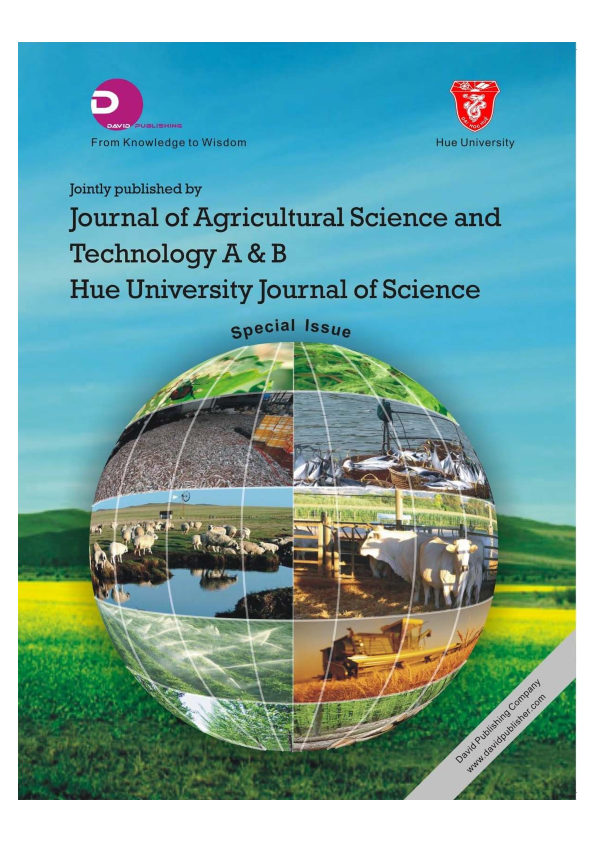DETERMINATION OF ILEAL AMINO ACID DIGESTIBILITIES OF SOME BY-PRODUCTS FOR CHICKENS
Abstract
Nghiên cứu này được thực hiện nhằm xác định tỷ lệ tiêu hóa hồi tràng tiêu chuẩn các amino acid trong 6 loại thức ăn phụ phẩm cho gà (khô dầu dừa, khô dầu hạt cải, bột lông vũ, bột gia cầm thủy phân, bột thịt xương và bột đầu tôm). Thí nghiệm được tiến hành trên gà Lương Phượng 35 ngày tuổi. Trong tất cả các khẩu phần, thức ăn thí nghiệm là nguồn cung cấp protein duy nhất. Trong trường hợp thức ăn thí nghiệm thuộc nhóm nguyên liệu giàu protein, dextrose được trộn vào khẩu phần để điều chỉnh hàm lượng protein tổng số trong phẩu phần khoảng 20%. Tỷ lệ tiêu hóa hồi tràng tiêu chuẩn của amino acid được tính trên cơ sở hiệu chỉnh tỷ lệ tiêu hóa hồi tràng biểu kiến của amino acid bằng lượng amino acid nội sinh cơ bản. Kết quả nghiên cứ cho thấy không có sự biến động lớn về tỷ lệ tiêu hóa các amino acid trong khô dầu hạt cải. Ngược lại, tỷ lệ tiêu hóa hồi tràng tiêu chuẩn các amino acid biến động khá lớn ở khô dầu dừa. Đối với nhóm nguyên liệu protein động vật, khoảng biến động về tỷ lệ tiêu hóa giữa các amino acid trong bột đầu tôm là thấp nhất. Tỷ lệ tiêu hóa amino acid hồi tràng tiêu chuẩn đối với Arg, His, Leu + Ile, Thr, Trp, Val và Phe ở bột gia cầm thủy phân và bột đầu tôm rất cao. Trong khi đó, tỷ lệ tiêu hóa Lys, Thr và Trp trong bột lông vũ là rất thấp. Bột thịt xương và bột lông vũ là 2 loại nguyên liệu có tỷ lệ tiêu hóa amino acid thấp nhất.References
AFZ, Eurolysine Ajinomoto, Nutrition Aventis Animal, INRA, ITCF (2000). AmiPig - Standardised ileal digestibility of amino acids in feedstuffs for pigs. CD-ROM.
Aikison J, Capenter KJ (1970). Nutritive value of meat meals. II. Influence of raw materials and processing on meat meal quality. Journal of the Science of Food and Agriculture, 21, 366-372.
AOAC (1990). Official methods of analysis. Fifteenth edition. Published by the Association of Official Analytical Chemists, Inc., Arlington-Virginia-USA.
Bryden WL and Li X (2004). Utilisation of digestible amino acids by broilers. RIRDC Publication No 04/030.
Bryden WL, Li X (2010). Amino acid digestibility and poultry feed formulation: expression, limitations and application. Revista Brasileira de Zootecnia, 39 (supl. especial), 279-287.
Eastoe JE, Long JE (1960). The amino acid composition of processed bones and meat meal. Journal of the Science of Food and Agriculture, 11, 87-92.
Fernandez SR, Zhang Y, Parsons CM (1995). Dietary formulation with cottonseed meal on a total versus a digestible amino acid basis. Poultry Science, 74, 1168-1179.
Garcia AR, Batal AB, Dale NM (2006). A comparison of methods to determine amino acid digestibility of feed ingredients for chickens. Poultry Science, 86, 94-101.
Ho Trung Thong, Ho Le Quynh Chau, Nguyen Xuan An, Vu Chi Cuong (2014). Determination of basal endogenous protein and amino acids in Luong Phuong chickens. Journal of Animal Science and Technology, 12, 14-19.
Hoehler D, Lemme A, Ravindran V, Bryden WL and Rostagno (2006). Feed formulation in broiler chickens based on standardized ileal amino acid digestibility. VIII Simposium Internacional de Nutrición Acuícola. Universidad Autónoma de Nuevo León, Monterrey, Nuevo Léon, México. ISBN 970-694-333-5.
NRC (2012). Nutrition requirements of swine. National Academy Press, Washington DC.
Ravindran V (2011). Poultry feed availability and nutrition in developing countries - Advances in poultry nutrition. FAO, Rome, Italy.
Ravindran V, Bryden WL (1999a). Evaluation of meat and bone meal in broiler starter diets formulated on the basis of total or digestible amino acids. Proceedings of the Australian Poultry Science Symposium, 11, 169.
Ravindran V, Bryden WL (1999b). Evaluation of broiler diets containing graded levels of cottonseed meal and formulated on the basis of total or digestible amino acids. Proceedings of the Australian Poultry Science Symposium, 11, 168.
Ravindran V, Bryden WL (1999c). Amino acid availability in poultry - in vitro and in vivo measurements. Australian Journal of Agricultural Research, 50(5), 889 - 908.
Ravindran V, Hew LI, Bryden WL (1998). Broiler feed formulations with canola meal based on total or digestible amino acids. Proceedings of the Australian Poultry Science Symposium, 10, 209.
Ravindran V, Hew LI, Ravindran G, Bryden WL (2005). Apparent ileal digestibility of amino acids in feed ingredients for broiler chickens. Animal Science, 81, 85-97.
Rostagno HS, Pupa JMR and Pack M (1995). Diet formulation for broiler based on total versus digestible amino acid. The Journal of Applied Poultry Research, 4, 293-299.
Skurray GR, Herbert LS (1974). Batch dry rendering: Influence of raw materials and processing conditions. Journal of the Science of Food and Agriculture, 25, 1071-1079.
Vogtmann H, Pfirter HP, and Prabucki AL (1975). A new method of determining metabolisability of energy and digestibility of fatty acids in broiler diets. British Poultry Science, 16(5), 531-534.
Wang X, Parsons CM (1998). Effect of raw material source, processing system, and processing temperatures on amino acid digestibility of meat and bone meals. Poultry Science, 77, 834-841.

